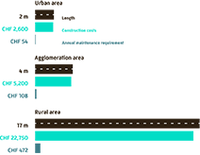2
Spatial Planning
Saves Resources
Kindly supported by Cinémathèque suisse.
Place: Ticino
Interviews: Paolo Poggiati, Chief Planner Canton of Ticino
Riccardo De Gottardi, Chief Officer Spatial Development Canton of Ticino
The goal of spatial planning is to steer building growth in today's existing cities and agglomerations in order to save on land, energy and infrastructure costs.
Land is a very valuable resource; it is not only in short supply, it cannot be increased. In spite of this, we have built upon so much land in recent decades that it would seem we have an unlimited supply. The more wasteful we are with our land, the more spread out our settlements are, the more streets, drainage systems and water pipelines we need – and the higher the cost of such extensive infrastructure. Any additional major development of the transport network is simply unaffordable. It is vital that our resources, that is to say land, public financing, energy and raw materials, are allocated efficiently and sustainably.
The development of settlements and the construction of relevant infrastructure should be closely coordinated. There is a need for compact developments, located in well-connected areas with multi-story buildings that are not scattered across large plots. The expansion of high-density settlements can be achieved through infill development, densification of inefficiently used plots, closing gap sites, and the adaptation and conversion of industrial brownfields. Further development of rural conglomerations for commuter communities should be avoided in the future, as these represent high levels of land consumption, additional traffic, and extensive and expensive infrastructure. We need building zones in the right areas, which means locations that are well connected via public transport.
Average Street Length Required per Inhabitant
Jährlich 65 Milliarden Franken für das Bauwerk Schweiz
Sofern am heutigen Ausbau und den geplanten Erweiterungen festgehalten wird, bestehen vor allem bei der Strassen- und Schieneninfrastruktur klare Lücken bei der Erneuerungsfinanzierung, zeigt eine Fokusstudie des Nationalen Forschungsprogramms «Nachhaltige Siedlungs- und Infrastrukturentwicklung» (NFP 54) erstmals in einer Gesamtschau.

